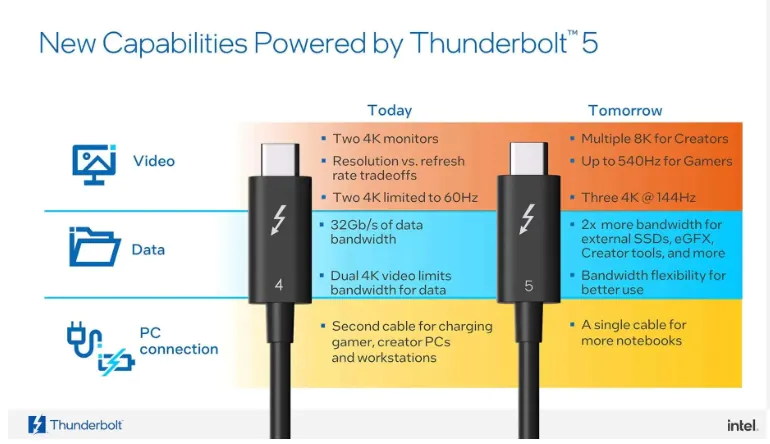© ROOT-NATION.com - Use of content is permitted with a backlink.
Originally available for MacBook Pro models, Thunderbolt has become a common interface for laptops. You’ve probably thought about it before. Whether you’re connecting an external graphics card or multiple high-resolution monitors to your laptop, the new Thunderbolt 5 is a viable choice.

However, the interface has gone through several generations since its introduction. And in case you’re not aware, Intel recently announced Thunderbolt 5, the latest connectivity standard with industry-leading speeds. Essentially, the new standard offers twice the bandwidth of Thunderbolt 4. But the question is, how does this translate to real-world use? That’s exactly what we’re about to show you.
If you don’t want to read, watch the video:

Thunderbolt 5 speed
To start with, Thunderbolt 5 continues to rely on the universal USB-C port. It’s the backbone of the interface. But that doesn’t mean that all USB-C ports support the latest standard. So, how do you know if your system supports it? Typically, Thunderbolt-enabled computers have a lightning bolt symbol on their USB-C ports. But to find out for sure if that port supports Thunderbolt 5, you need to consider the maximum throughput. However, how much does the new standard improve throughput?
The fastest USB4 devices have a maximum bandwidth of 40 Gbps using two lanes of 20 Gbps each. But in reality, most USB devices use a single lane that provides a maximum throughput of 20 Gbps.

In 2021, Thunderbolt 4 upped that speed to a maximum of 32 Gbps. But it supported a total bandwidth of up to 40 Gbps. With Thunderbolt 5, you get a maximum bandwidth of 64 Gbps with a total bandwidth of 80 Gbps. So, by comparison, the new standard is twice as fast as the previous standard. With twice the data transfer rate, it goes without saying that Thunderbolt 5 supports more video connections. In comparison, the predecessor could handle two 4K displays at 60Hz. On the other hand, the newest interface can support three 4K displays at 144Hz.
External displays
In addition, you can connect 8K displays at 60 Hz, which was not possible with Thunderbolt 4. The new standard has four shared lines with two 40Gbps lines in each direction. The new standard channel can also allocate three lines for different bandwidth-hungry applications. This provides an increase in bandwidth of up to 120 Gbps.
According to Intel’s statement, the bandwidth boost feature will be triggered to connect displays that exceed Thunderbolt 5’s base bandwidth of 80Gbps. This means it can be applied to monitor connections, and can be applied when you connect multiple 4K or 8K resolution displays over a single connection.

When Thunderbolt was introduced, it quickly became popular for gaming laptops due to its support for PCI Express. Yes, this is the same interface that your specialised graphics cards use. However, Thunderbolt’s 40Gbps bandwidth wasn’t enough to handle high-end GPUs. This made an external graphics enclosure less worthwhile.
External graphics processors
But with Thunderbolt 5, it looks like external graphics enclosures are making a comeback. With higher bandwidth and support for PCI Express Gen 4, external systems will allow you to get the most out of high-performance GPUs.
Sure, the bandwidth is still not on par with what you would get from a standard PCIe Gen 4 x16. But you also have to consider that most GPUs don’t fill the full bandwidth of Gen 4 x16 slots. So even if you use external graphics card enclosures with Thunderbolt 5, you’ll get less performance than before.
Charging speed
With Thunderbolt 4, you can get charging speeds of up to 100W via USB Power Delivery 3.0. In comparison, the new standard offers charging speeds of 140W. This means that the new standard is better able to cope with high power consumption devices, which include laptops.

Additionally, with Thunderbolt 5, manufacturers have the ability to support up to 240W of power via USB Power Delivery 3.1. Eventually, this will allow users to charge their high-powered gaming laptops via USB only.
Compatibility
If you’re already in the Thunderbolt ecosystem, you don’t need to worry too much about the gradual transition to Thunderbolt 5. Like its predecessors, the new interface is backwards compatible. And more importantly, the interface supports other versions of USB as well. This means that you can use Thunderbolt 4 accessories and cables in the new standard. However, in these cases, you won’t be able to take full advantage of the new standard. For example, charging speeds, data transfer speeds, and bandwidth will not be the same as with accessories designed for the new standard.

That said, backwards compatibility with Thunderbolt 5 is a great thing. After all, it allows you to use your old accessories with a new laptop that supports the new standard.
Summary
So, in conclusion, Thunderbolt 5 is a big step up from its predecessor in almost every aspect. You get twice the bandwidth, allowing you to enjoy faster data transfers. The increased charging speed means you can finally connect your laptop to the docking station with a single cable.

And let’s not forget to mention that Thunderbolt 5 will make external graphics enclosures trendy again. This will make it possible to get a full gaming set-up with not too powerful laptops.
Read also:
- ASUS Vivobook S15 OLED review: a laptop for real work
- ASUS ExpertBook B9 (B9403CVA) laptop review: lightweight, stylish, productive

